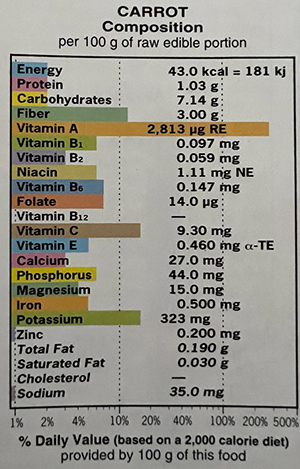Contents
Carrots and alfalfa greens are the most decadent foods in provitamin A, making them an essential dietary medicine. Learn more about the benefits of eating carrots in greater detail.

Scientific Facts about Carrots
- Scientific name: Daucus carota L.
- French: Carotte.
- Spanish: Zanahoria.
- Description: The root of the carrot plant (‘Daucus carots’L.) is an herb of the family Umbelliferae that can reach up to one meter in height. It is usually orange, although there are varieties of purple or yellow.
- Environment: Originally from Southern Europe and the Near East. Today it is cultivated in moderate regions worldwide, primarily in China, the United States, and France.

Benefits of Eating Carrots
Carrots contain a small but significant amount of proteins (1.03 percent), approximately half that of potatoes. Fats are almost absent (0.19 percent), and carbohydrates make up 7.14 percent of their weight. Carrots are a relatively good source of B-group vitamins and vitamins C and E. All minerals and trace elements, including iron (0.5 mg/100 grams), are present.

Three properties stand out in the structure of carrots:
- Carotenoids are among the most significant, including beta-carotene, which the body converts into vitamin A. Carotenoids are vital for correct retina functioning, especially for night vision or low-light settings. The vegetable also helps keep the skin and mucosa in excellent condition.
- Vegetable fiber: Carrots contain about three percent, most of which is pectin. This helps regulate stool transit and soothes the intestinal mucosa.
- Essential oil: This is active against intestinal parasites.
Carrots are beneficial in general diseases of the retina and the eyes, skin disorders, gastritis, excess gastric acid, colitis, and cancer prevention.
How to use Carrots
- Raw: In salads, whole or grated and dressed with lemon juice. Carrots strengthen children’s teeth.
- Cooked: Carrots blend well with potatoes and other vegetables. They are sweeter when cooked. They maintain their beta-carotene content after cooking.
- Juice: Carrot juice makes refreshing, delicious, and nutritious beverages. It merges very well with apple juice or lemon juice.
DISCLAIMER: All content on this website is presented solely for educational and informational objectives. Do not rely on the information provided as a replacement for advice, diagnosis, or treatment from a qualified medical expert. If you are pregnant, nursing, or have any preexisting medical concerns, talk to your doctor before using any herbal or natural medicines.
REFERENCES
- George D. Pamplona-Roger, M.D. “Encyclopedia of Foods and Their Healing Power.” George D. Pamplona-Roger, M.D. Encyclopedia of Foods and Their Healing Power. Trans. Annette Melgosa. Vol. 2. Chai Wan: Editorial Safeliz, 2005. 25. Print. [benefits of eating carrots]
- American Optometric Association (AOA): https://www.aoa.org/news/clinical-eye-care/health-and-wellness/eating-for-your-eyes
- Harvard School of Public Health: https://www.hsph.harvard.edu/nutritionsource/carbohydrates/fiber/
- Journal of Agricultural and Food Chemistry: https://www.ncbi.nlm.nih.gov/pmc/articles/PMC7071392/
- National Institutes of Health (NIH): https://www.nih.gov/
- PubMed: https://pubmed.ncbi.nlm.nih.gov/
Last update on 2025-05-29 / Affiliate links / Images from Amazon Product Advertising API





